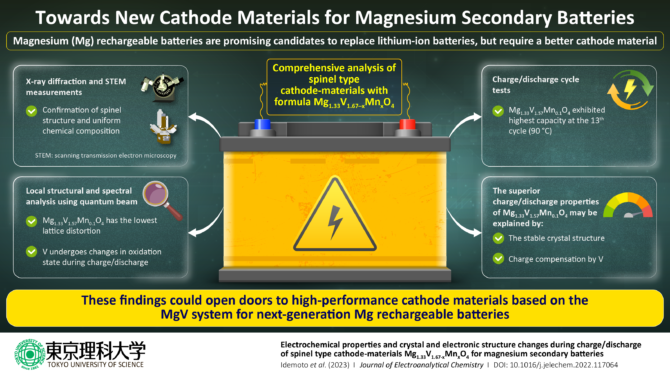
Scientists discover optimal composition for a magnesium battery cathode
By Tokyo University of Science (TUS)
Electronics Power Supply / Management Engineering battery Japan power research Tokyo UniversityReplacement for Li-ion batteries achieves better cyclability and high battery capacity
Magnesium is a promising candidate as an energy carrier for next-generation batteries. However, the cycling performance and capacity of magnesium batteries need to improve if they are to replace lithium-ion batteries.
To this end, a research team focused on a novel cathode material with a spinel structure, Mg1.33V1.67−xMnxO4. Following extensive characterization and electrochemical performance experiments, they have found a specific composition that could open doors to high-performance magnesium rechargeable batteries.
Use in everything from portable electronics to cellular base stations
Lithium-ion batteries have remained unrivalled in terms of overall performance for several applications, as evidenced by their widespread use in everything from portable electronics to cellular base stations. However, they suffer from few important disadvantages that are difficult to ignore.
For one, lithium is rather expensive, and the fact that it is being mined at an extreme pace does not help. Moreover, the energy density of lithium-ion batteries is not enough to grant autonomy to electric vehicles and heavy machinery. These concerns, coupled with the fact that the batteries are highly unsafe when punctured or at high temperatures, have caused scientists to look for alternative technologies.

Among the various elements being tested as efficient energy carriers for rechargeable batteries, magnesium (Mg) is a promising candidate. Apart from its safety and abundance, Mg has the potential to realize higher battery capacities. However, some problems need to be solved first. These include the low voltage window that Mg ions provide, as well as the unreliable cycling performance observed in Mg battery materials.
Improve the performance of cathode materials
To tackle these issues, a research team led by Vice President and Professor Yasushi Idemoto from Tokyo University of Science, Japan has been on the lookout for new cathode materials for Mg batteries. In particular, they have been searching for ways to improve the performance of cathode materials based on the MgV (V: vanadium) system. Fortunately, as reported in a recent study made available online on 8 December 2022 and published in Volume 928 of the Journal of Electroanalytical Chemistry on 1 January 2023, they have now found the right track to success.
The researchers focused on the Mg1.33V1.67O4 system but substituted some amount of vanadium with manganese (Mn), obtaining materials with the formula Mg1.33V1.67−xMnxO4, where xgoes from 0.1 to 0.4. While this system offered high theoretical capacity, more details about its structure, cyclability, and cathode performance needed to be analyzed to understand its practical utility. Accordingly, the researchers characterized the synthesized cathode materials using a wide variety of standard techniques.
Evaluate the battery performance
First, they studied the composition, crystal structure, electron distribution, and particle morphologies of Mg1.33V1.67−xMnxO4compounds using X-ray diffraction and absorption, as well as transmission electron microscopy. The analyses showed that Mg1.33V1.67−xMnxO4 has a spinel structure with a remarkably uniform composition. Next, the researchers conducted a series of electrochemical measurements to evaluate the battery performance of Mg1.33V1.67−xMnxO4, using different electrolytes and testing the resulting charge/discharge properties at various temperatures.
The team observed a high discharge capacity for these cathode materials—especially Mg1.33V1.57Mn0.1O4—but it also varied significantly depending on the cycle number. To understand why, they analyzed the local structure near the vanadium atoms in the material. “It appears that the particularly stable crystal structure along with a large amount of charge compensation by vanadium leads to the superior charge–discharge properties we observed for Mg1.33V1.57Mn0.1O4,” remarks Prof. Idemoto. “Taken together, our results indicate that Mg1.33V1.57Mn0.1O4 could be a good candidate cathode material for magnesium rechargeable batteries.”
Future research and development
Satisfied with the present findings and hopeful about what is to come, Prof. Idemoto concludes: “Through future research and development, magnesium batteries could surpass lithium-ion batteries thanks to the former’s higher energy density.”
Indeed, substituted MgV systems could eventually lead to the much awaited next-generation batteries. Let us hope the highly anticipated alternative to lithium for our rechargeable battery needs will be realized soon!
—————————-
Reference
DOI: https://doi.org/10.1016/j.jelechem.2022.117064
Tokyo University of Science
Tokyo University of Science (TUS) is the largest science-specialized private research university in Japan, with four campuses in central Tokyo and its suburbs and in Hokkaido. Established in 1881, the university has continually contributed to Japan’s development in science through inculcating the love for science in researchers, technicians, and educators.
